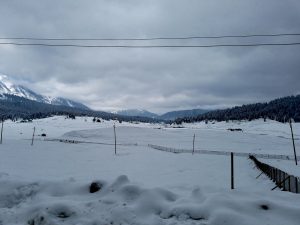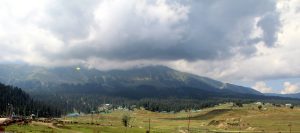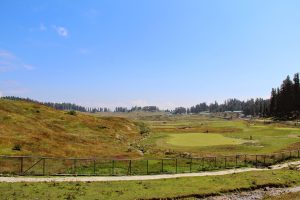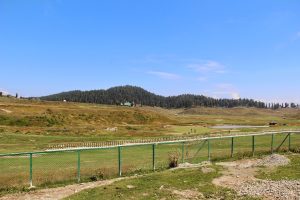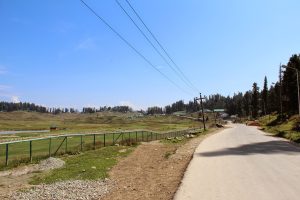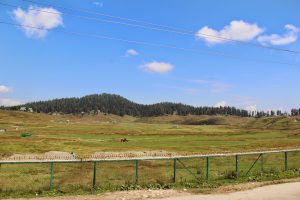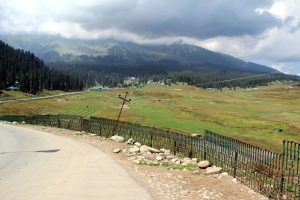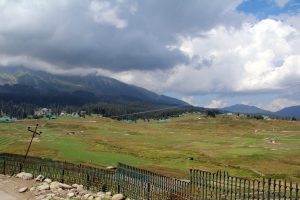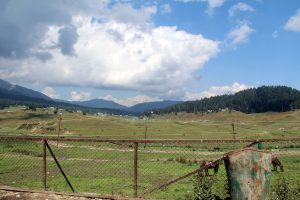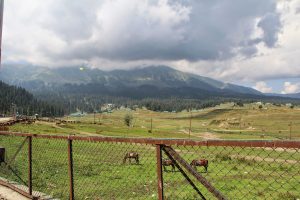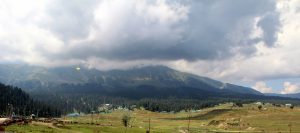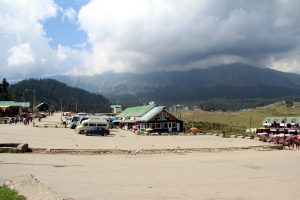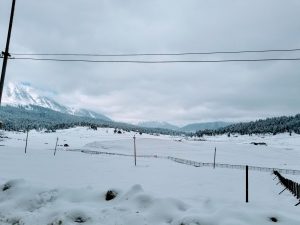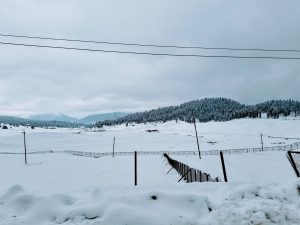It had been 25 years since I had visited Gulmarg. My urge to revisit it was intense, but more intense than that was to find its soul; because I had always wondered why many people thought it to be the epitome of the Kashmir vacation places; even greater than Pahalgam.
On August 17 I reluctantly departed from Pahalgam and headed almost straight to Gulmarg, except for a brief stopover in Srinagar.
Leaving Srinagar we took Highway IA, a major highway in J & K. Beyond Srinagar airport, into Bemina, a fast developing suburb, we drove toward Gulmarg. The highway up to about Bemina was a 4-lane road, which I was told was going to be expanded into a 6-lane road. Kashmir was finally coming of age to become a user-oriented place.
On the way to Gulmarg, my taxi driver stopped at an orchid. The buxom apples, ripening into red skin, which was enveloping a still developing rich juiciness. One was tempted to pluck them.
Tangmarg, the stop before Gulmarg, existing in the shadow of Gulmarg’s glory, has a personality of its own. There are visitors who like to stay in it, for its charms, facilities, and its self-effacing image. It is the headquarters of the military guarding Gulmarg, which is close to Pakistan. No military stays in Gulmarg, to give the tourists a chance to forget the Kashmir Problem for a little while. The road between Tangmarg and Gulmarg has seen a great upgrade since I traveled on it last. You find pines and other trees on it, setting up an aura of natural glory of the entire area.
At the end of the Tangmarg-Gulmarg road one suddenly sees a vast panoramic site of a natural meadow, circumferenced by tall, graceful mountains, dotted by magnificently tall and slender pine trees. This is the Gulmarg of the legends and tourism literature.
The central area of Gulmarg is a natural bowl, green but with many bald spots and weeds on it. It is 1.86 square miles area, with a length of 1.8 and a width of 0.62 miles. The average altitude of Gulamrg is 8, 825 ft., its highest point is 13,780 ft., at Apharwat mountain. Looking at just the “face “of Gulmarg, one is puzzled by its reputation as the best tourist place in Kashmir.
During spring Gulmarg meadow is swamped with bluebells, daisies, forget-me-nots, and buttercups, to the extent that it made the last Sultan of Kashmir, Yusuf Shah Chak (ruled 1579-86), to change its name from Gaurimarg (Gauri was Lord Shiva’s consort) to Gulmarg, which in Urdu means a meadow of flowers. (marg means meadow) The king may have been ignorant of the significance of its original name and insensitive to smothering its history; like many kings of earlier times, his personal emotion was generally more important than anything else. The romantic Mughal king Jahangir(1569-1627) was also a lover of Gulmarg. Aurel Stein, the noted British archeologist (who among other things discovered the text of Diamond Sutra), lived in a tent in Gulmarg, between his field trips.
In the modern times, British rediscovered Gulmarg, in 1927; establishing the golf club, which still exists. It became a hot vacation spot for the colonizers, including its military. They found the snow-bound slopes of Gulmarg a fit place to expend their passions for nature and sports.
The central valley of Gulmarg, the meadow that has given it its name, has been poorly landscaped; in fact it has not been landscaped at all, just left “natural.” Many beautiful things could have been done to it: conversion to a park, embedded with organized flower-beds, trees, plants, walking-paths, benches, etc. The finished product would be a sophisticated garden blending with the basic scenery of Gulmarg, which is high mountains, embroidered with high pine trees. Instead of that what we have is a nearly two square miles of a primitive landscape. The custodian of Gulmarg, the state government, thinks that by leaving it “natural” it is imparting Gulmarg the greatest artistry. Internationally reputed public park landscapers have to be invited to submit proposals for the drastic facelift of the Gulmarg’s “face.”
Gulmarg has about 40 hotels, some good, others sunk into mediocrity. But it has no downtown: no good shops, no bars. The only whiff of a downtown that it has is a rambling, primitive bazaar. The absence of bars is due to the prohibition on alcohol, to an extent that only one state-run liquor store is allowed, which was closed due to the ongoing Ramadan. Without some sort of entertainment, besides golfing and skiing, the vacationers, after soaking nature for most of the time, feel bored.
My search for the soul of Gulmarg made me realize that it does not so much lie in its central meadow, but in its higher level places of Khilanmarg valley, Apharwat mountain, Alpather lake, and beyond. This area is like the forehead of Gulmarg, while its central meadow its bosom. From here you see the majestic sweep of the pine forests and beyond them the valley of Kashmir. On a clear day one can see the mountains Nanga Parbat (26,660 ft., in Pakistan) and Harmukh (16,870 + ft.) The grandeur of the views afforded transport you to a higher level experience of nature, creating a mood of enchantment, wonder, awe, and selflessness.
It is the Upper Gulmarg (a name I am giving to the ensemble of places at the higher altitudes than the main meadow of Gulmarg) that attracts Gulmarg’s most ardent admirers, the skiers. Gulmarg is one of the top skiing places in the world, because of its high altitude, the length of its skiing track, and the scenery it commands. From December to March, Gulmarg is converted to a vast skiing arena, bringing glory to the place, as well as money to the entrepreneurs. The irony is that through the skiing fame of Gulmarg, the government tries to lure tourists to the other parts of Kashmir, which may be more beautiful than Gulmarg.
All the high success of Upper Gulmarg would not have been possible without the cable car system, called Gondola here, which was installed in 1998. It ferries skiers, trekkers, and general purpose tourists from the Gulmarg base station, at 8,530 ft. elevation, to Kongdoori (in Khilanmarg valley), in its first stage. In the second stage, which opened in 2005, Gondola goes from Kongdoori to a station at 12,959 ft., near Apharwat mountain peaks. The highest point of Gulmarg is at 13,780 ft., at a peak of Apharwat mountain. Gondala was engineered by the French company Pomagalski. Because of the success of skiing, another cable car system running parallel to the second stage of Gondola, which will run from Kongdoori to a place called Mary’s Shoulder, in Apharwat mountain peaks, is being planned by the company. It will cater to beginner and intermediate-level skiers. Gondola fares are low. Horse owners and guides are fighting with the government for compensation to them for the loss to their trades due to the Gondola.
I stayed in hotel Grand Mumtaz, a reasonably good place. I walked to the downtown bazaar, rather than take a taxi or horse, to feel the grounds of Gulmarg and contemplate its scene better. There is a 7 mile road which goes round Gulmarg, called Outer Ring Road, providing a walk through pine forests and affording panoramic views of Kashmir valley and mountains that are also visible from Upper Gulmarg. Gulmarg has a golf course, at 8,694 ft., touted to be either at the highest altitude or among the top group of high altitude golf courses in the world. It is very interesting, and lends to good reason, that for security reasons, due to its proximity to Pakistan, that no local people can stay for nights in Gulmarg, except for hotel operators and critical government personnel. The population is only 664.
In Gulmarg one’s sight gazes at distant panoramic horizons, while at Pahalgam it is more restricted. This gives Gulmarg a greater visual heft, which translates into a more spiritual and romantic experience. In the arms of nature one feels the hand of something higher, a tug for something impersonal.
Following day I packed my stuff and drove down through the meadow of Gulmarg, onto to the steep Gulmarg-Tangmarg road. Going downhill on this road indicates a departure from Gulmarg, the queen of panoramic sights, where the romance with the mountains leaves an everlasting impression on one’s life. I bade goodbye to Gulmarg reluctantly, for I had just discovered what its soul is and where it lay, and I needed some more time to absorb that.
See the photos of the trips:
Copy and paste the below link in internet search (Google Search) to see the photos.
When the Google Photos page opens go to the top-right corner of the page and find
three vertical dots, click on them and slideshow starts.
https://photos.app.goo.gl/ytxy2jqmBKhcNoyT6
Suffern, New York, October 18, 2011 www.kaulscorner.com maharaj.kaul@yahoo.com; Rev May 12, 2024.
